Abstract
Looking at data on fruit vegetables in Japanese agriculture, particularly summer/autumn tomatoes, the national harvest volume in 2022 will be 322,000 tons, and the cultivated area nationwide will be 7,380 hectares. It is one of the important crops in Japanese agriculture, maintaining stable yields and cultivated area. Additionally, shipping volume data shows that Hokkaido has the largest shipping volume. This indicates that Hokkaido plays an important role in tomato production. Overall, summer/autumn tomato production in Japan is stable, and although production volumes vary between regions, it can be said that supply is meeting demand.
Summer/autumn tomato harvest yields (main data).
Japan’s summer/autumn tomato harvest volume has fluctuated between 1973 and 2022. The largest harvest was recorded in 1975, with 754 thousand tons nationwide. However, in the decades since, yields have fluctuated and are currently at 42.7% of their peak. Possible factors behind this trend include technological innovations in agriculture, changes in economic conditions, and climate change. Especially recently, climate change is likely affecting the growth and harvesting of summer-autumn tomatoes, which may have contributed to the decline in yields. Changes in agricultural policies and market demand may also affect yields. Overall, summer-autumn tomato yields have fluctuated over the past few decades, with multiple factors contributing to this variability.
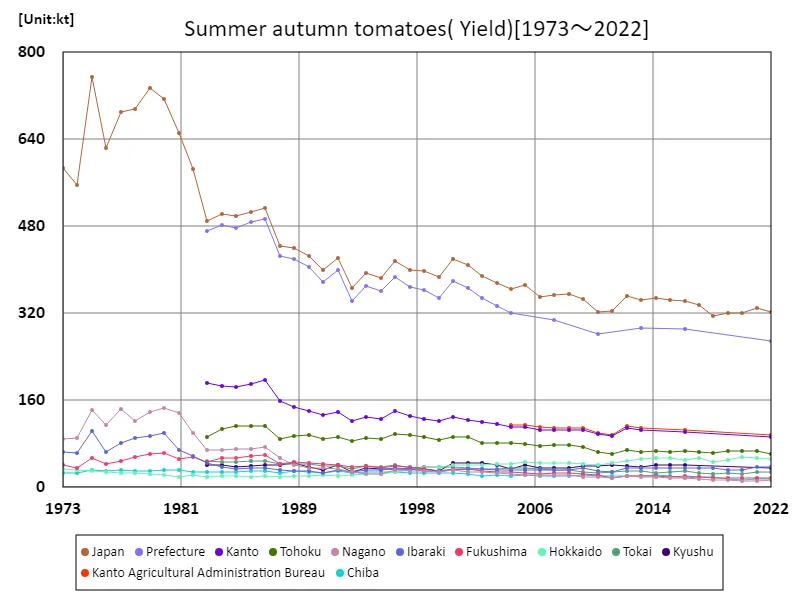

The maximum is 754kt[1975] of Japan, and the current value is about 42.7%
Summer/autumn tomato harvest volume (by prefecture).
According to the latest data for 2022, Hokkaido’s fruit vegetable harvest in Japan was the highest overall at 52,400 tons. This data is interesting and shows that Hokkaido plays a major role in fruit vegetable production. Hokkaido, with its vast farmland and relatively cool climate, is an ideal region for growing fruit vegetables, with high yields recorded. On the other hand, harvest yields in other regions tend to be lower than in Hokkaido. This may be due to differences in regional climate, soil conditions and agricultural techniques. Changes in agricultural policies and market demand may also affect yields. Generally speaking, some regions, including Hokkaido, are major producing areas for fruit and vegetables, and production volumes differ between these regions.
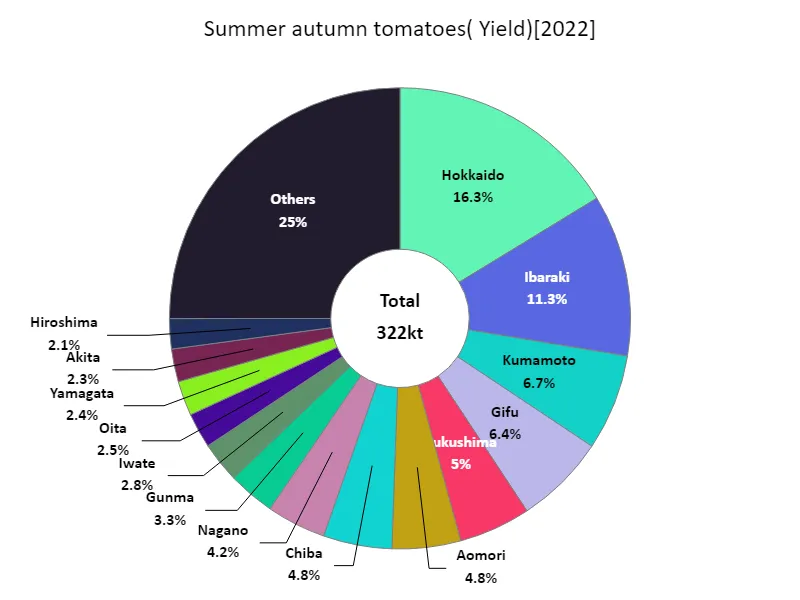

The maximum is 52.4kt of Hokkaido, the average is 6.85kt, and the total is 322kt
Area planted with summer and autumn tomatoes (main data).
The area of cultivated summer/autumn tomatoes in Japanese agriculture has fluctuated between 1973 and 2022. The maximum cultivated area was recorded in 1980 at 15.4 thousand hectares nationwide, but it has declined since then and is currently at 47.9% of the peak. There are several possible factors behind this trend. First, structural changes in agriculture may be reducing the area dedicated to summer-autumn tomato production. Also, changes in demand and consumer preferences may be at play. For example, it is possible that cultivation of summer-autumn tomatoes is declining due to increased demand for other vegetables and fruits, as well as an increase in imports. Additionally, the effects of climate change and natural disasters may also affect acreage fluctuations. Overall, the area planted to summer/autumn tomatoes has been decreasing over the past few decades, suggesting that multiple factors, including changes in the agricultural structure, changes in demand, and climate change, are behind this.
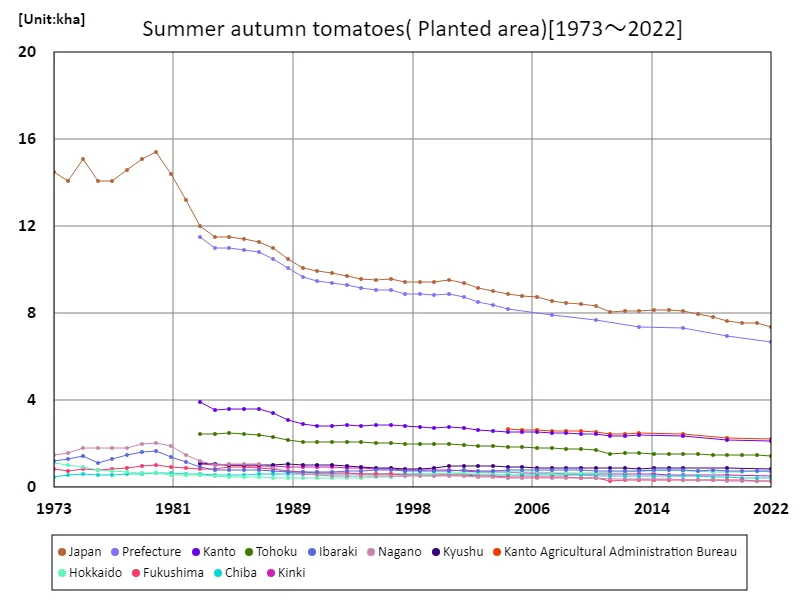

The maximum is 15.4kha[1980] of Japan, and the current value is about 47.9%
Area planted with summer and autumn tomatoes (by prefecture).
Looking at the data for the area of fruit and vegetable cultivation in Japan for 2022, the largest overall is Ibaraki Prefecture at 744 hectares, which is the current maximum value. It is noteworthy that Ibaraki Prefecture ranks first in the nation in terms of the area cultivated with fruit vegetables. This suggests that Ibaraki Prefecture has land and climatic conditions suitable for agriculture, making it well suited to producing fruit vegetables. Additionally, Ibaraki Prefecture has the largest area of land devoted to fruit vegetables in the country, indicating that it is an important producer of fruit vegetables. On the other hand, the cultivated area in other regions is smaller than that in Ibaraki Prefecture, suggesting that there are differences in cultivated amounts from region to region. This is due to the different land, climatic conditions and agricultural characteristics of each region, and reflects the diversity of agriculture among regions. Generally speaking, some areas, including Ibaraki Prefecture, are major producing areas for fruit vegetables, and a notable feature is that there are differences in cultivated area between these areas and other regions.
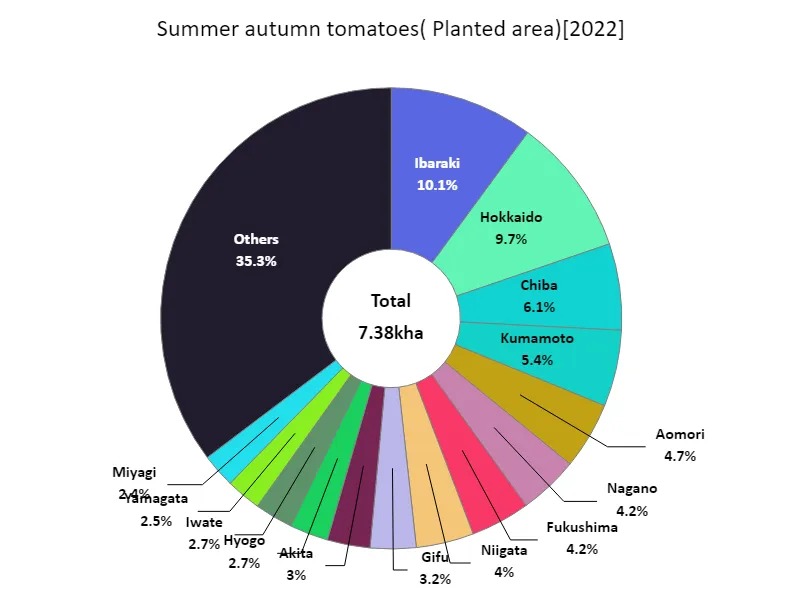

The maximum is 744ha of Ibaraki, the average is 157ha, and the total is 7.38kha
Summer and autumn tomato shipping volume.
Looking at the shipping volume data for summer and autumn tomatoes in Japan in 2022, the largest overall was Hokkaido with 48,900 tons, the average was 5,940 tons, and the total was 279,000 tons. It is interesting to note that Hokkaido has the largest shipping volume. Hokkaido, with its vast farmland and cool climate, is well suited to growing summer and autumn tomatoes. Therefore, it is only natural that Hokkaido recorded the largest shipping volume. On the other hand, the average shipping volume was 5,940 tons, suggesting that summer/autumn tomatoes are also grown in areas other than Hokkaido. This reflects the regional characteristics due to differences in climate and land conditions. In addition, the total shipping volume of 279,000 tons indicates that summer/autumn tomato production is thriving throughout Japan. Summer-autumn tomatoes are one of Japan’s important agricultural products and are grown extensively to meet demand. Generally speaking, some areas, including Hokkaido, are major producers of summer/autumn tomatoes, and a stable shipping volume is maintained throughout Japan.
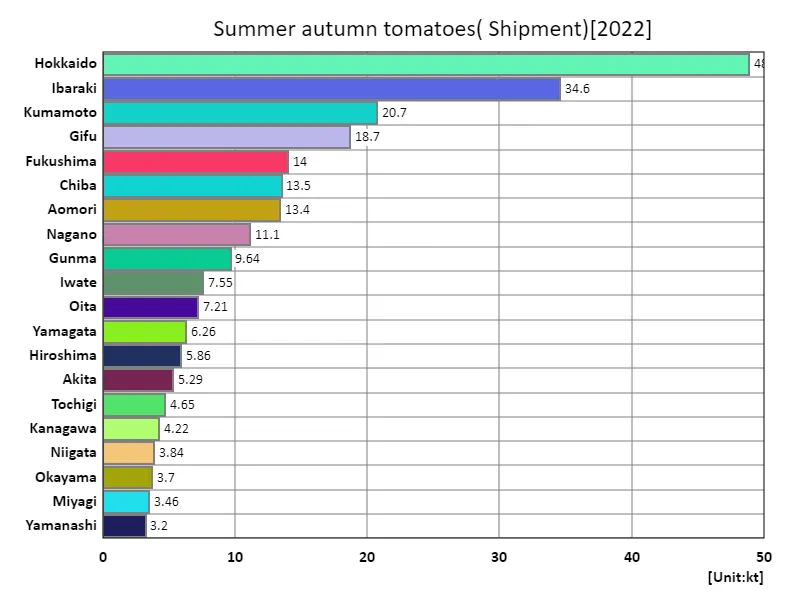

The maximum is 48.9kt of Hokkaido, the average is 5.94kt, and the total is 279kt
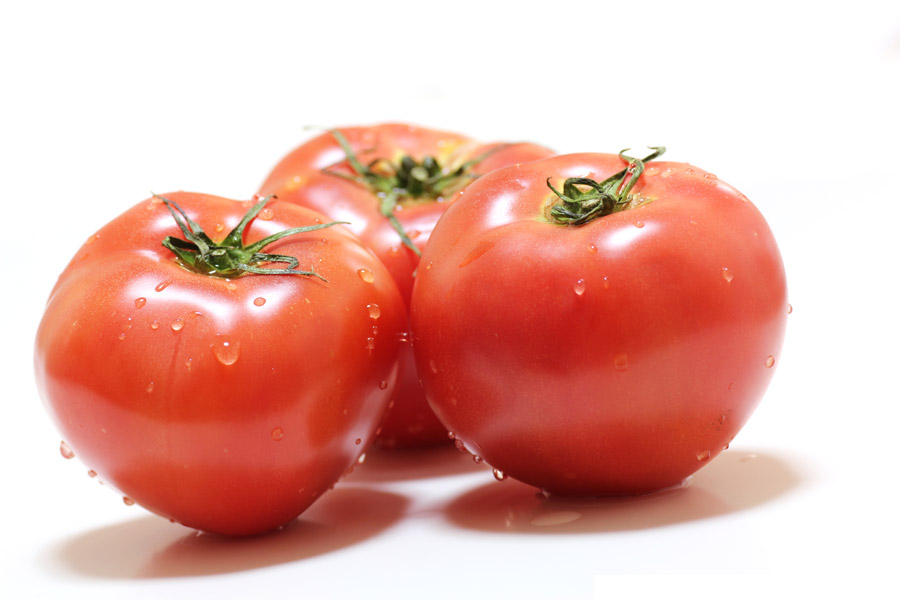


Comments